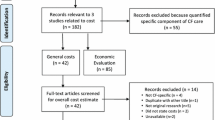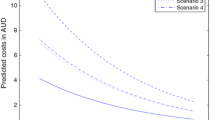Abstract
Background
Cystic fibrosis (CF) is a genetic disorder that is most common in white children and young adults. Long-term survival has improved steadily and will likely increase with the recent introduction of neonatal screening and causative treatment. However, these advances have substantial economic consequences for healthcare systems and payers.
Objective
This study aims to determine the economic burden of CF and to elucidate the structure of costs and the distribution of resources for different subpopulations, treatment strategies and sites of care for CF in Germany.
Methods
We conducted an observational cohort study to evaluate the economic burden of CF and the costs of treatment within different CF substrata from a payer perspective. Using claims data from a large German sickness fund, we identify the causal effect of CF on costs, service utilisation, and premature mortality. We compare the outcomes of a CF and a control group using entropy balancing and regression techniques, conduct further analyses for the CF group to gain insight into the economic burden associated with different levels of disease severity, and analyse pharmaceutical expenditures by collecting all CF-related expenses on outpatient drug treatment from the sickness fund database.
Results
Direct medical costs caused by CF in Germany in 2016 average €17,551 per patient-year and appear to be mainly driven by the cost of outpatient drug prescriptions (€12,869). We estimate that the national burden of disease totals €159 million. Costs increase with disease severity and related complications. If all eligible CF patients in the German population were to receive CF mutation-specific drugs, the economic burden of disease would more than triple to €594 million.
Conclusion
CF has a constant and wide-ranging economic impact on payers, with considerable differences in the distribution of costs and service utilisation between younger and older patients as well as mild vs. severe patients. Pharmaceutical expenses will increase in the future as causative treatment gains importance. We encourage the use of a control group approach for burden-of-disease studies to be able to identify causal effects and thus to obtain more precise estimates.
Similar content being viewed by others
References
Farrell PM. The prevalence of cystic fibrosis in the European Union. J Cyst Fibros. 2008;7:450–3.
Hirsch EB, Tam VH. Impact of multidrug-resistant Pseudomonas aeruginosa infection on patient outcomes. Expert Rev Pharmacoeconomics Outcomes Res. 2010;10:441–51.
Mauldin PD, Salgado CD, Hansen IS, Durup DT, Bosso JA. Attributable hospital cost and length of stay associated with health care-associated infections caused by antibiotic-resistant gram-negative bacteria. Antimicrob Agents Chemother. 2010;54:109–15.
Sykes J, Stanojevic S, Goss CH, Quon BS, Marshall BC, Petren K, et al. A standardized approach to estimating survival statistics for population-based cystic fibrosis registry cohorts. J Clin Epidemiol. 2016;70:206–13.
McPhail GL, Clancy JP. Ivacaftor: the first therapy acting on the primary cause of cystic fibrosis. Drugs Today (Barc). 2013;49:253–60.
Rowe SM, Miller S, Sorscher EJ. Cystic fibrosis. N Engl J Med. 2005;352:1992–2001.
Zhou M, Balg C, Luhnen M. Ivacaftor (neues Anwendungsgebiet) – Bewertung gemäß § 35a Abs. 1 Satz 10 SGB V. Köln: Institute for Quality and Efficiency in Health Care (IQWiG); 2016.
Zhou M, Balg C, Luhnen M. Lumacaftor / Ivacaftor – Bewertung gemäß § 35a Abs. 1 Satz 10 SGB V. Köln: Institute for Quality and Efficiency in Health Care (IQWiG); 2016.
Wietrychowski R. Qualitätssicherung mukoviszidose. 2012. 2012. https://www.muko.info/fileadmin/user_upload/angebote/qualitaetsmanagement/register/berichtsbaende/qualitaetssicherung_mukoviszidose_2012.pdf. Accessed 13 Dec 2018.
Holland PW. Statistics and causal inference. J Am Stat Assoc. 1986;81:945–60.
Pearl J. Causal inference in the health sciences: a conceptual introduction. Health Serv Outcomes Res Methodol. 2001;2:189–220.
Rosenbaum PR. From association to causation in observational studies: the role of tests of strongly ignorable treatment assignment. J Am Stat Assoc. 1984;79:41–8.
Rubin DB. Estimating causal effects of treatments in randomized and nonrandomized studies. J Educ Psychol. 1974;66:688–701.
Imbens GW. Nonparametric estimation of average treatment effects under exogeneity: a review. Rev Econ Stat. 2004;86:4–29.
Institute for Quality and Efficiency in Health Care (IQWiG). Working paper: cost estimation. 2009. https://www.iqwig.de/download/Working_Paper_Cost_Estimation.pdf. Accessed 13 Dec 2018.
Hainmueller J. Entropy balancing for causal effects: a multivariate reweighting method to produce balanced samples in observational studies. Political Anal. 2017;20:25–46.
Imai K, King G, Stuart EA. Misunderstandings between experimentalists and observationalists about causal inference. J R Stat Soc Ser A. 2008;171:481–502.
Elixhauser A, Steiner C, Harris DR, Coffey RM. Comorbidity measures for use with administrative data. Med Care. 1998;36:8–27.
Kuo RN, Dong YH, Liu JP, Chang CH, Shau WY, Lai MS. Predicting healthcare utilization using a pharmacy-based metric with the WHO’s anatomic therapeutic chemical algorithm. Med Care. 2011;49:1031–9.
Ho DE, Imai K, King G, Stuart EA. Matching as nonparametric preprocessing for reducing model dependence in parametric causal inference. Political Anal. 2007;15:199–236.
Schisterman EF, Cole SR, Platt RW. Overadjustment bias and unnecessary adjustment in epidemiologic studies. Epidemiology. 2009;20:488–95.
Gardner JW, Sanborn JS. Years of potential life lost (YPLL)—what does it measure? Epidemiology. 1990;1:322–9.
Federal Statistical Office. Kohortensterbetafeln für Deutschland. Wiesbaden: Federal Statistical Office; 2017.
King G, Zeng L. The dangers of extreme counterfactuals. Political Anal. 2006;14:131–59.
Krauth C, Jalilvand N, Welte T, Busse R. Cystic fibrosis: cost of illness and considerations for the economic evaluation of potential therapies. Pharmacoeconomics. 2003;21:1001–24.
Weiner JR, Toy EL, Sacco P, Duh MS. Costs, quality of life and treatment compliance associated with antibiotic therapies in patients with cystic fibrosis: a review of the literature. Expert Opin Pharmacother. 2008;9:751–66.
Hollin IL, Robinson KA. A scoping review of healthcare costs for patients with cystic fibrosis. Appl Health Econ Health Policy. 2016;14:151–9.
Ouyang L, Grosse SD, Amendah DD, Schechter MS. Healthcare expenditures for privately insured people with cystic fibrosis. Pediatr Pulmonol. 2009;44:989–96.
Baumann U, Stocklossa C, Greiner W, von der Schulenburg JM, von der Hardt H. Cost of care and clinical condition in paediatric cystic fibrosis patients. J Cyst Fibros. 2003;2:84–90.
Chevreul K, Michel M, Brigham KB, Lopez-Bastida J, Linertova R, Oliva-Moreno J, et al. Social/economic costs and health-related quality of life in patients with cystic fibrosis in Europe. Eur J Health Econ. 2016;17:7–18.
Schreyogg J, Hollmeyer H, Bluemel M, Staab D, Busse R. Hospitalisation costs of cystic fibrosis. Pharmacoeconomics. 2006;24:999–1009.
Heimeshoff M, Hollmeyer H, Schreyogg J, Tiemann O, Staab D. Cost of illness of cystic fibrosis in Germany: results from a large cystic fibrosis centre. Pharmacoeconomics. 2012;30:763–77.
Angelis A, Tordrup D, Kanavos P. Socio-economic burden of rare diseases: a systematic review of cost of illness evidence. Health Policy. 2015;119:964–79.
Kopciuch D, Zaprutko T, Paczkowska A, Nowakowska E. Costs of treatment of adult patients with cystic fibrosis in Poland and internationally. Public Health. 2017;148:49–55.
Chevreul K, Brigham KB, Michel M, Rault G. Costs and health-related quality of life of patients with cystic fibrosis and their carers in France. J Cyst Fibros. 2015;14:384–91.
Jackson AD, Jackson AL, Fletcher G, Doyle G, Harrington M, Zhou S, et al. Estimating direct cost of cystic fibrosis care using Irish registry healthcare resource utilisation data, 2008–2012. Pharmacoeconomics. 2017;35:1087–101.
Grosse SD, Do TQN, Vu M, Feng LB, Berry JG, Sawicki GS. Healthcare expenditures for privately insured US patients with cystic fibrosis, 2010–2016. Pediatr Pulmonol. 2018;53:1611–8.
Vadagam P, Kamal KM. Hospitalization costs of cystic fibrosis in the United States: a retrospective analysis. Hosp Pract. 1995;2018(46):203–13.
Dewitt EM, Grussemeyer CA, Friedman JY, Dinan MA, Lin L, Schulman KA, et al. Resource use, costs, and utility estimates for patients with cystic fibrosis with mild impairment in lung function: analysis of data collected alongside a 48-week multicenter clinical trial. Value Health. 2012;15:277–83.
Author information
Authors and Affiliations
Corresponding author
Ethics declarations
Funding
No funding was received for this study.
Conflict of interest
S. Frey, T. Stargardt, U. Schneider and J. Schreyögg declare they have no conflict of interest relevant to this study.
Informed consent
Informed consent was obtained from all individual participants included in the study.
Author contributions
SF and US had complete access to the pseudonymised study dataset and were responsible for data collection. SF, TS, and JS designed the study. SF analysed the data and was responsible for statistical programming. SF and TS prepared the first draft, and JS and US revised the manuscript. All authors approved the final manuscript.
Data availability statement
The data that support the findings of this study are owned by the Techniker Krankenkasse (Bramfelder Straße 140, 22305 Hamburg, Germany) and so are not publicly available. To fulfil the legal requirements to access the data, researchers must obtain permission for a specific research question from the German Federal (Social) Insurance Office and conclude a contract with the sickness fund. The study must also be approved by the data protection officer, both at the sickness fund and the research institute, as well as the local ethics committee.
Rights and permissions
About this article
Cite this article
Frey, S., Stargardt, T., Schneider, U. et al. The Economic Burden of Cystic Fibrosis in Germany from a Payer Perspective. PharmacoEconomics 37, 1029–1039 (2019). https://doi.org/10.1007/s40273-019-00797-2
Published:
Issue Date:
DOI: https://doi.org/10.1007/s40273-019-00797-2




